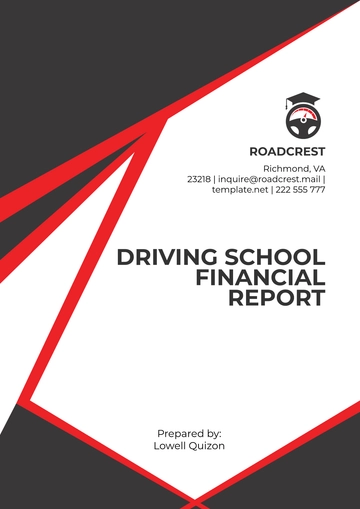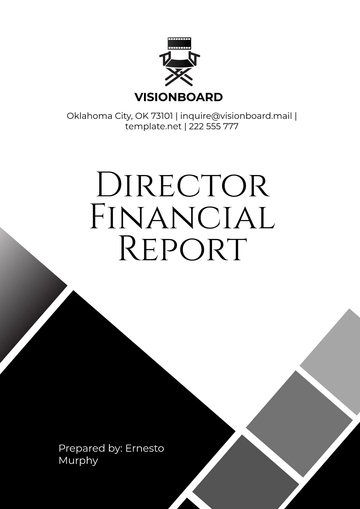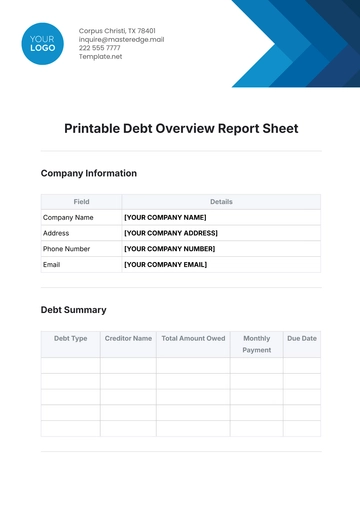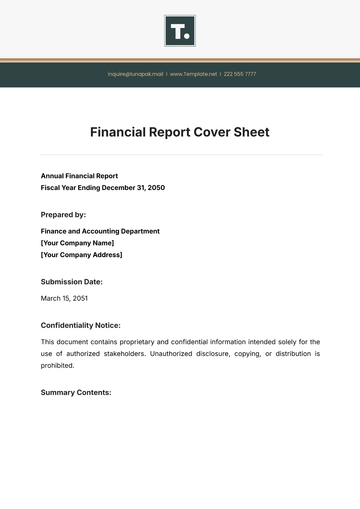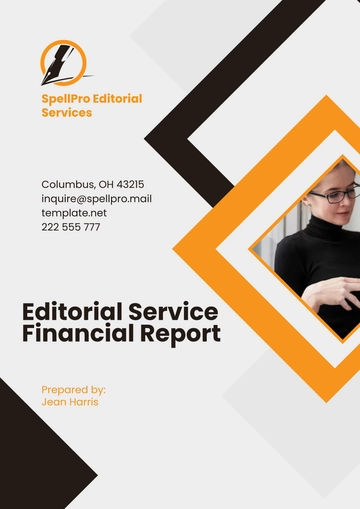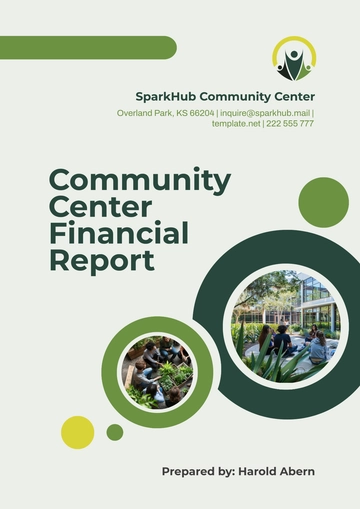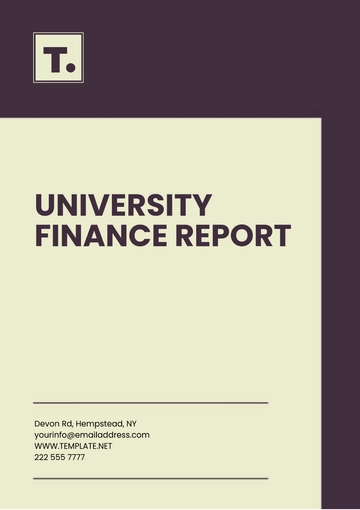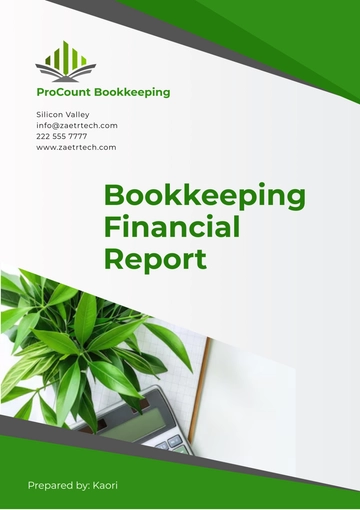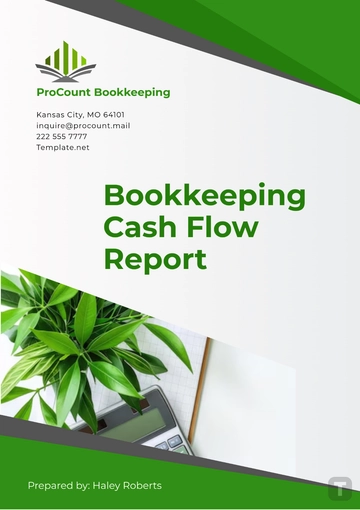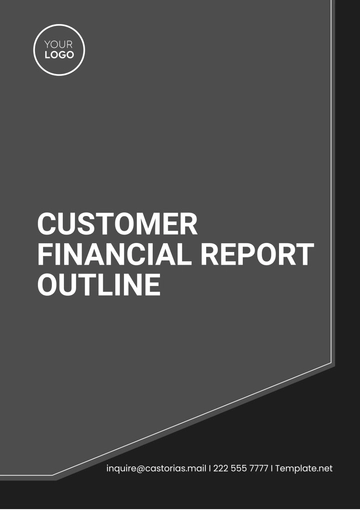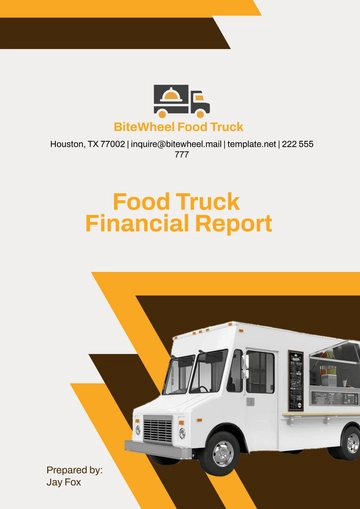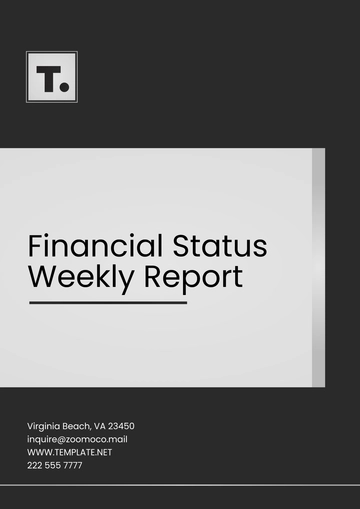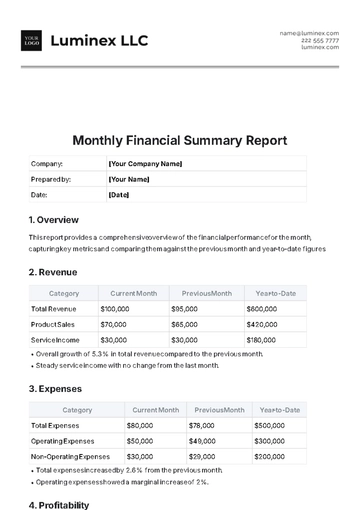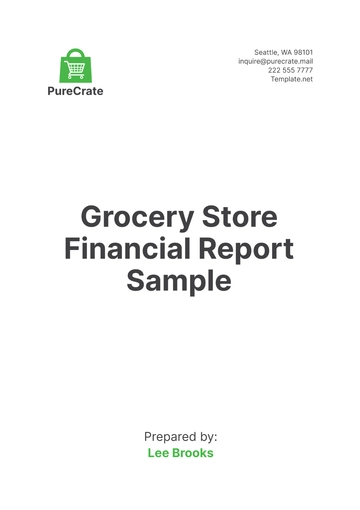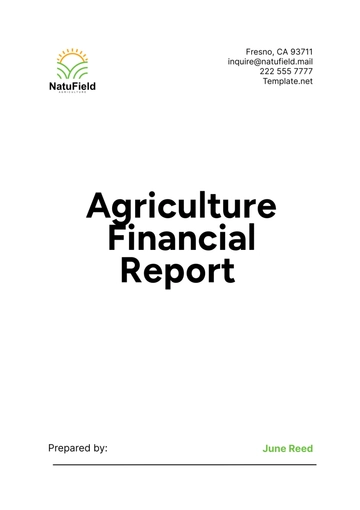Free Travel Agency Financial Report
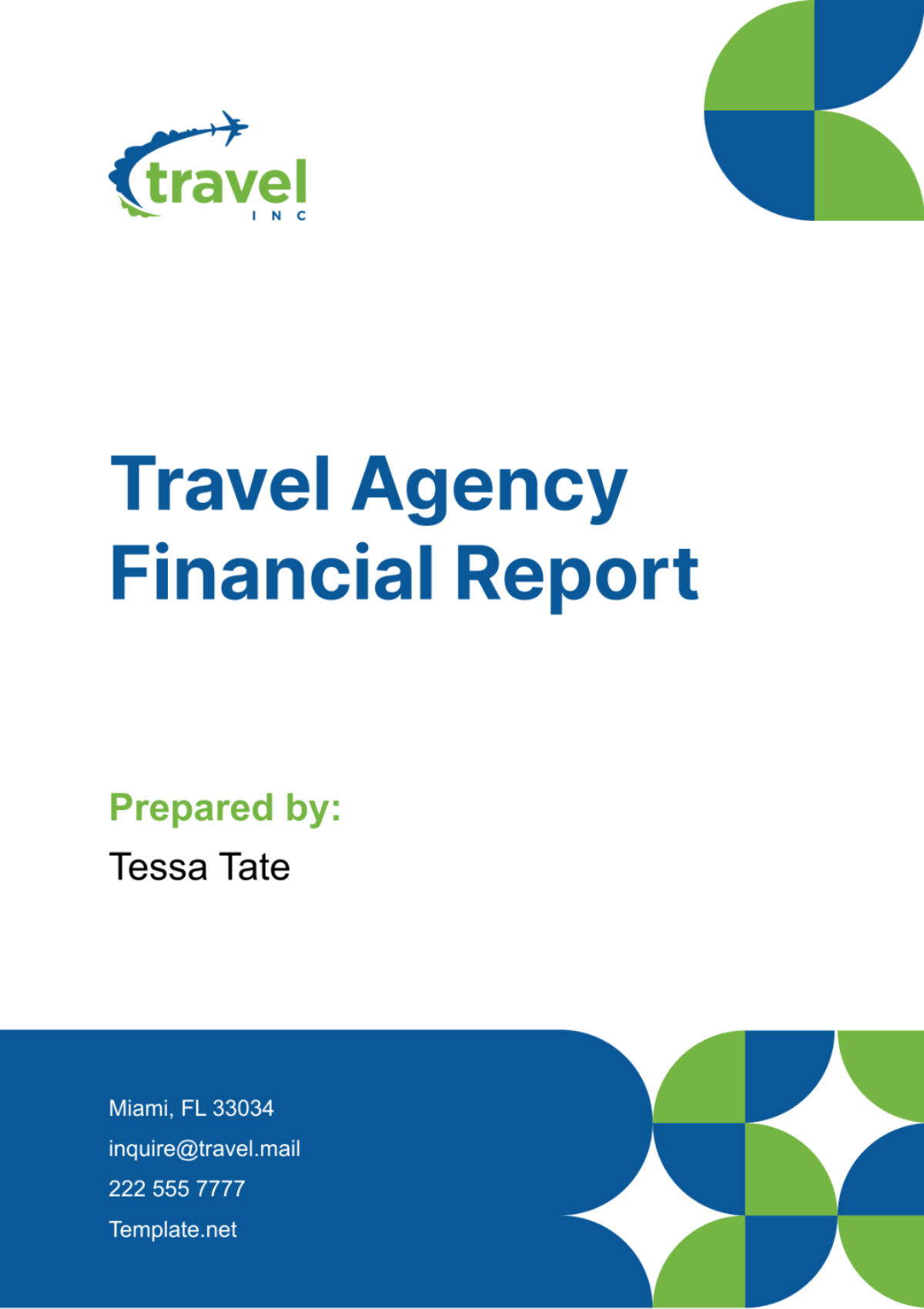
I. Executive Summary
A. Introduction
This financial report provides an in-depth analysis of the fiscal performance of [Your Company Name], a leading travel agency, for the period spanning from January 1, [Year] to December 31, [Year]. It offers insights into the company's financial health, operational efficiency, and market positioning.
The report aims to offer stakeholders, including investors, management, and partners, a comprehensive understanding of [Your Company Name]'s performance and to facilitate informed decision-making for future growth strategies.
B. Purpose of the Report
The primary purpose of this report is to assess the financial performance of [Your Company Name] during the specified period.
Additionally, it seeks to identify areas of strength and improvement within the company's operations and financial management.
Furthermore, the report aims to provide strategic insights and recommendations for enhancing [Your Company Name]'s competitiveness and profitability in the travel industry.
C. Scope of Analysis
The analysis in this report covers a wide range of financial metrics, including revenue streams, operational expenses, profitability margins, and key financial ratios.
It also includes a detailed examination of revenue breakdown by service, expense allocation, operational efficiency metrics, and market trends affecting [Your Company Name]'s performance.
D. Key Findings
Total revenue for the fiscal year reached [$5,000,000], reflecting a notable [15%] increase compared to the previous year. This growth can be attributed to [specific factors such as increased demand, expanded service offerings, or improved marketing efforts].
Among the various services offered by [Your Company Name], accommodation services emerged as the highest revenue contributor, generating [$2,500,000], followed by flights with [$1,800,000].
Despite challenges such as increasing competition and fluctuating market demand, [Your Company Name] maintained a robust gross profit margin of [25%], indicating efficient cost management practices.
Operational challenges include [brief description of challenges, such as rising operational costs or technological disruptions], which require [Your Company Name] to adopt agile strategic responses.
Based on the findings, recommendations have been formulated to address identified areas for improvement and capitalize on growth opportunities, including diversifying revenue streams, optimizing marketing efforts, and investing in technology to enhance operational efficiency.
II. Financial Highlights
A. Revenue Analysis
Total Revenue: [$5,000,000]
Revenue Growth: [15%]
Revenue Breakdown by Service:
Service Type | Revenue |
|---|---|
Flights | [$1,800,000] |
Accommodation | [$2,500,000] |
Tours & Activities | [$600,000] |
Other Services | [$100,000] |
Profitability Analysis
Gross Profit Margin: [25%]
Net Profit Margin: [18%]
Key Financial Ratios
Current Ratio: [2.5:1]
Debt-to-Equity Ratio: [0.75]
B. Operational Highlights
Expense Category | Amount |
|---|---|
Marketing | [$800,000] |
Staff Salaries | [$1,200,000] |
Technology | [$300,000] |
Rent & Utilities | [$250,000] |
Other Expenses | [$350,000] |
Cost Saving Initiatives: Implementation of automated booking systems to reduce labor costs.
Operational Challenges: Competition from online travel agencies impacting profit margins.
C. Customer Satisfaction
Customer Feedback Analysis
Survey Results: Overall satisfaction rate of 85%.
Complaints Analysis: Main issues include booking errors and communication delays.
Market Trends Analysis
Industry Trends: Shift towards experiential travel and sustainable tourism.
Competitive Landscape: Emergence of niche travel agencies targeting specific demographics.
III. Financial Performance Analysis
A. Revenue Analysis
The revenue trend analysis provides insights into the fluctuations and patterns in [Your Company Name]'s revenue over the fiscal year [Year]. This analysis aids in understanding the company's performance and identifying potential growth opportunities or challenges.
Monthly Revenue Comparison
This section compares the monthly revenue figures throughout the fiscal year [Year]. By examining month-to-month variations, [Your Company Name] can identify seasonal trends, peak periods, and areas for revenue optimization.
Quarterly Revenue Trends
Quarterly revenue trends offer a broader view of [Your Company Name]'s revenue performance. Analyzing revenue trends on a quarterly basis allows for the identification of longer-term patterns and the evaluation of the effectiveness of strategic initiatives implemented during each quarter.
Annual Revenue Growth: [15%]
The annual revenue growth indicates the percentage increase in [Your Company Name]'s total revenue compared to the previous fiscal year. In this case, [Your Company Name] experienced a commendable 15% growth, reflecting positive performance and potentially successful business strategies.
The revenue breakdown by service provides a detailed overview of the contribution of each service offered by [Your Company Name] to the total revenue. This breakdown helps in understanding the revenue distribution and the relative importance of each service in [Your Company Name]'s overall revenue generation.
B. Profitability Analysis
Profit margin analysis focuses on evaluating [Your Company Name]'s profitability by examining various margin metrics.
Gross Profit Margin Trend
The gross profit margin trend indicates the percentage of revenue retained by [Your Company Name] after deducting the cost of goods sold (COGS). Monitoring the trend helps in assessing the efficiency of [Your Company Name]'s pricing strategy and cost management practices.
Net Profit Margin Trend
The net profit margin trend reflects the percentage of revenue remaining as net income after deducting all expenses, including operating expenses, taxes, and interest. Analyzing this trend provides insights into [Your Company Name]'s overall profitability and financial performance.
Profitability Trends: [Analysis]
We provided a comprehensive analysis of profitability trends based on gross and net profit margins. It includes insights into factors influencing profitability, such as changes in revenue, cost structures, and market conditions.
C. Expense Analysis
Expense analysis entails examining [Your Company Name]'s expenditure patterns to assess operational efficiency and cost management strategies.
Expense Trend Analysis
Expense trend analysis involves comparing monthly and quarterly expenses to identify patterns, fluctuations, and potential areas for cost optimization.
Monthly Expense Comparison: This comparison evaluates monthly variations in expenses, highlighting any significant deviations from budgeted or historical expenses.
Quarterly Expense Trends: Quarterly expense trends provide insights into the consistency and sustainability of [Your Company Name]'s expenditure patterns over time.
Annual Expense Variation: [Analysis]
This offers an analysis of the annual variation in expenses, examining factors contributing to changes in expenditure and their impact on [Your Company Name]'s financial performance.
D. Financial Ratios
Financial ratios provide valuable insights into [Your Company Name]'s liquidity, solvency, and overall financial health.
Liquidity Ratios
Current Ratio: [2.5:1]: The current ratio measures [Your Company Name]'s ability to meet short-term obligations using its current assets. A ratio of 2.5:1 indicates that [Your Company Name] has $2.5 in current assets for every $1 of current liabilities.
Quick Ratio: [1.8:1]: The quick ratio assesses [Your Company Name]'s immediate liquidity by excluding inventory from current assets. A ratio of 1.8:1 suggests [Your Company Name] has sufficient liquid assets to cover short-term liabilities.
Cash Ratio: [0.5:1]: The cash ratio evaluates [Your Company Name]'s ability to cover short-term liabilities with its cash and cash equivalents. A ratio of 0.5:1 indicates [Your Company Name] has $0.50 in cash for every $1 of short-term liabilities.
Solvency Ratios
Debt-to-Equity Ratio: [0.75]: The debt-to-equity ratio measures [Your Company Name]'s leverage by comparing its total debt to shareholders' equity. A ratio of 0.75 suggests [Your Company Name] has a moderate level of debt relative to equity.
Debt Ratio: [30%]: The debt ratio assesses [Your Company Name]'s reliance on debt financing by comparing total debt to total assets. A ratio of 30% indicates that [Your Company Name] finances 30% of its assets with debt.
Interest Coverage Ratio: [5.0]: The interest coverage ratio evaluates [Your Company Name]'s ability to cover interest expenses with its earnings before interest and taxes (EBIT). A ratio of 5.0 suggests [Your Company Name] generates sufficient earnings to meet interest obligations five times over.
IV. Operational Performance Analysis
A. Sales Performance
Sales Volume Analysis
Total Sales Volume: [$8,000,000]
This represents the total revenue generated by [Your Company Name] from sales of various travel services during the fiscal year [Year]. It indicates the overall performance of the company in terms of revenue generation.
Sales Volume by Service:
This breakdown illustrates the contribution of each service offered by [Your Company Name] to the total sales volume. It helps identify which services are driving revenue growth and which may require additional focus or improvement.
Service Type | Sales Volume |
|---|---|
Flights | [$3,500,000] |
Accommodation | [$4,000,000] |
Tours & Activities | [$500,000] |
Other Services | [$1,000,000] |
B. Customer Satisfaction
Customer Feedback Analysis
Survey Results:
Overall satisfaction rate: 85%
This metric represents the percentage of customers who reported being satisfied with their experience with [Your Company Name]. It provides an overview of the company's performance in meeting customer expectations.
Satisfaction with booking process: 90%
This indicates the satisfaction level of customers with the ease, convenience, and accuracy of the booking process offered by [Your Company Name].
Satisfaction with customer service: 80%
This metric reflects the satisfaction level of customers with the assistance and support provided by [Your Company Name]'s customer service representatives.
Main issues:
Booking errors (20%), Communication delays (15%), Billing discrepancies (10%)
This analysis highlights the most common complaints received by [Your Company Name] from customers. Understanding these issues enables the company to address root causes and improve service quality.
C. Operational Efficiency
Key Performance Indicators (KPIs)
Average Transaction Value: [$500]
This KPI measures the average value of each transaction conducted by [Your Company Name]'s customers. It indicates the effectiveness of upselling or cross-selling strategies and the overall purchasing behavior of customers.
Conversion Rate: 20%
The conversion rate represents the percentage of leads or inquiries that result in successful sales transactions. A higher conversion rate indicates more efficient sales processes and marketing efforts.
Customer Acquisition Cost: [$50 per customer]
This metric calculates the average cost incurred by [Your Company Name] to acquire a new customer. It helps evaluate the efficiency of marketing and advertising campaigns in attracting new business.
D. Market Trends Analysis
Industry Trends
Shift towards experiential travel and sustainable tourism.
This trend reflects changing consumer preferences towards immersive and environmentally responsible travel experiences. [Your Company Name] can capitalize on this trend by offering curated experiences and eco-friendly travel options.
Growing demand for personalized travel experiences.
With an increasing focus on individual preferences and unique travel itineraries, [Your Company Name] can differentiate its offerings by providing customized travel packages and personalized services.
Competitive Landscape
Emergence of niche travel agencies targeting specific demographics.
The rise of niche travel agencies catering to specific market segments presents both challenges and opportunities for [Your Company Name]. By identifying underserved niches and tailoring its services accordingly, [Your Company Name] can carve out its own niche in the market.
Increased competition from online travel agencies and aggregator platforms.
The proliferation of online travel agencies and aggregator platforms has intensified competition in the travel industry. [Your Company Name] can enhance its competitiveness by offering unique value propositions, such as personalized service, expert advice, and exclusive deals.
V. Conclusion and Recommendations
A. Summary of Findings
Key Observations
[Your Company Name] experienced healthy revenue growth of 15% compared to the previous year, driven by strong performance across all service categories. This growth reflects the effectiveness of [Your Company Name]'s sales and marketing strategies.
Customer satisfaction remains high, with an overall satisfaction rate of 85%, indicating [Your Company Name]'s commitment to delivering exceptional service. However, there are opportunities to address common complaints and further improve the customer experience.
Operational efficiency indicators, such as average transaction value and conversion rate, are in line with industry standards, demonstrating effective management practices and customer engagement strategies.
Identified Trends
Industry trends indicate a shift towards experiential travel and sustainable tourism, presenting opportunities for [Your Company Name] to differentiate its offerings and attract environmentally-conscious travelers.
Increasing competition from niche travel agencies and online platforms underscores the need for [Your Company Name] to continuously innovate and differentiate its services to maintain its competitive edge.
B. Recommendations
Strategic Initiatives
Expand offerings in experiential travel and sustainable tourism to cater to evolving consumer preferences and capitalize on growing market demand.
Strengthen online marketing efforts and invest in digital platforms to enhance [Your Company Name]'s online presence and reach a wider audience.
Operational Improvements
Implement proactive measures to address common complaints, such as improving booking processes and communication channels, to enhance the overall customer experience.
Continuously monitor and optimize key performance indicators to improve operational efficiency and drive sustainable growth.
C. Future Outlook
Forecasted Financial Performance
Based on current trends and strategic initiatives, [Your Company Name] projects a 10% revenue growth for the upcoming fiscal year. This growth will be supported by targeted marketing efforts, expanded service offerings, and improved operational efficiency.
Anticipated improvements in customer satisfaction and operational efficiency will further strengthen [Your Company Name]'s position in the market and drive long-term profitability.
Growth Opportunities
Explore partnerships with local experience providers to enhance the portfolio of tours and activities, offering unique and authentic travel experiences to customers.
Leverage customer data and analytics to personalize marketing campaigns and improve customer retention, fostering long-term relationships and loyalty.
- 100% Customizable, free editor
- Access 1 Million+ Templates, photo’s & graphics
- Download or share as a template
- Click and replace photos, graphics, text, backgrounds
- Resize, crop, AI write & more
- Access advanced editor
Track your agency's financial performance with Template.net's Travel Agency Financial Report Template. This customizable document provides a structured format for presenting key financial metrics, including revenue, expenses, profitability, and cash flow. With clear sections for income statements, balance sheets, and cash flow statements, it helps you analyze financial health and make informed decisions. Editable in our Ai Editor Tool for seamless customization and integration into your agency's reporting processes.
You may also like
- Sales Report
- Daily Report
- Project Report
- Business Report
- Weekly Report
- Incident Report
- Annual Report
- Report Layout
- Report Design
- Progress Report
- Marketing Report
- Company Report
- Monthly Report
- Audit Report
- Status Report
- School Report
- Reports Hr
- Management Report
- Project Status Report
- Handover Report
- Health And Safety Report
- Restaurant Report
- Construction Report
- Research Report
- Evaluation Report
- Investigation Report
- Employee Report
- Advertising Report
- Weekly Status Report
- Project Management Report
- Finance Report
- Service Report
- Technical Report
- Meeting Report
- Quarterly Report
- Inspection Report
- Medical Report
- Test Report
- Summary Report
- Inventory Report
- Valuation Report
- Operations Report
- Payroll Report
- Training Report
- Job Report
- Case Report
- Performance Report
- Board Report
- Internal Audit Report
- Student Report
- Monthly Management Report
- Small Business Report
- Accident Report
- Call Center Report
- Activity Report
- IT and Software Report
- Internship Report
- Visit Report
- Product Report
- Book Report
- Property Report
- Recruitment Report
- University Report
- Event Report
- SEO Report
- Conference Report
- Narrative Report
- Nursing Home Report
- Preschool Report
- Call Report
- Customer Report
- Employee Incident Report
- Accomplishment Report
- Social Media Report
- Work From Home Report
- Security Report
- Damage Report
- Quality Report
- Internal Report
- Nurse Report
- Real Estate Report
- Hotel Report
- Equipment Report
- Credit Report
- Field Report
- Non Profit Report
- Maintenance Report
- News Report
- Survey Report
- Executive Report
- Law Firm Report
- Advertising Agency Report
- Interior Design Report
- Travel Agency Report
- Stock Report
- Salon Report
- Bug Report
- Workplace Report
- Action Report
- Investor Report
- Cleaning Services Report
- Consulting Report
- Freelancer Report
- Site Visit Report
- Trip Report
- Classroom Observation Report
- Vehicle Report
- Final Report
- Software Report


